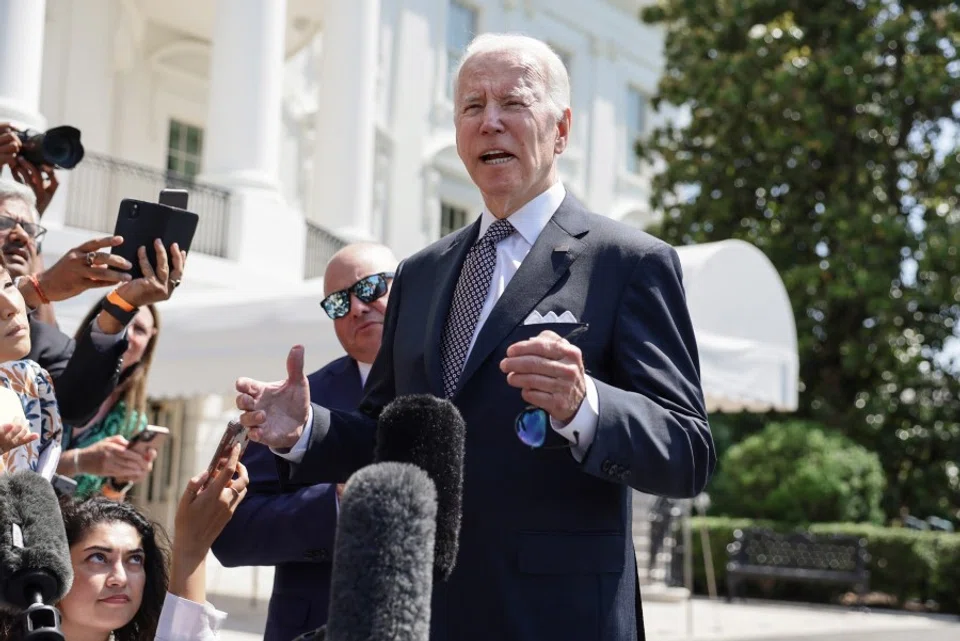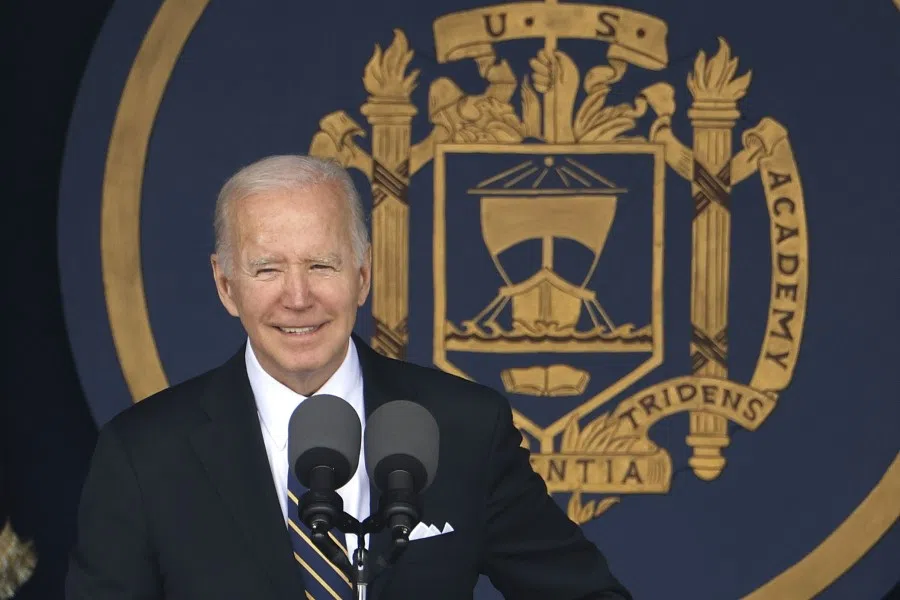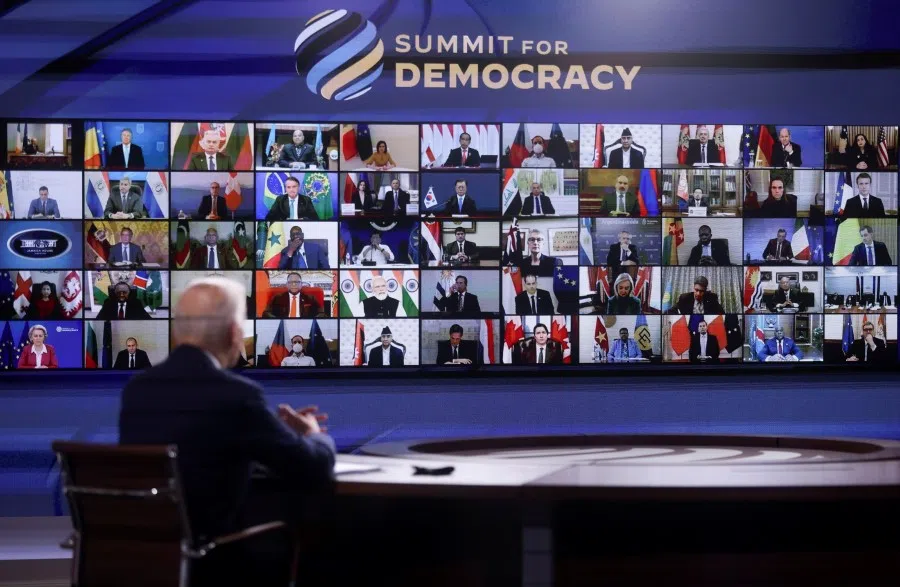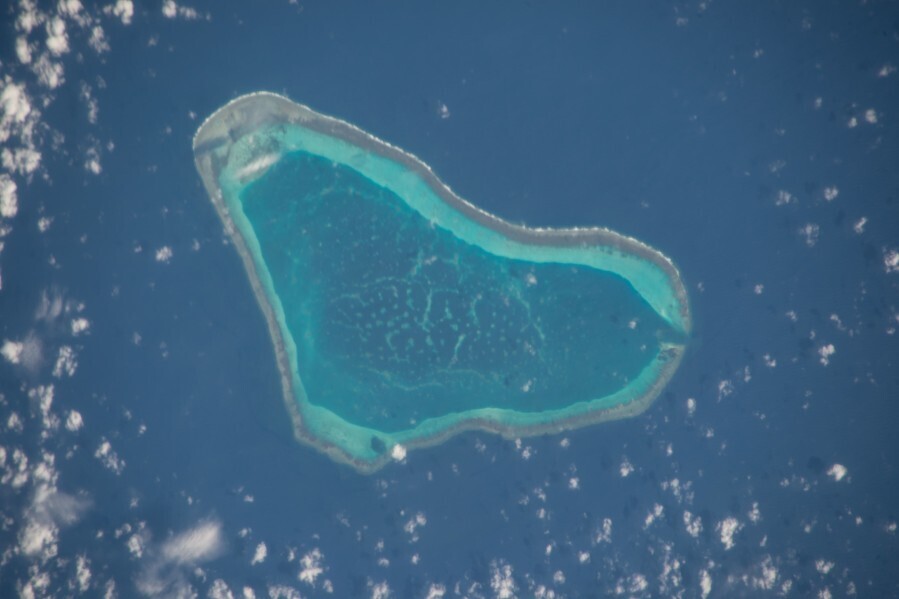US sets up strategic obstacles against 'autocratic' China
Political commentator William He notes that the Biden administration is clear and sharp with its China policy and strategy. It is setting up strategic obstacles to contain "autocratic" China, addressing long-term fundamental issues such as the right to speak on global values and order, and maintaining the lead in military powers and forming alliances.

There are three major differences in the China policies of the Biden and Trump administrations.
Firstly, compared to his officials, US President Joe Biden takes a tougher stance on China. The opposite was true with former US president Donald Trump.
Biden often puts China-US relations in the context of a 21st century tussle between democracy and autocracy, but US Secretary of State Antony Blinken's 26 May speech on the US's China policy did not allude to such a statement.
While Trump's colleagues drew a line between China and the Chinese Communist Party (CCP), and between the CCP and the Chinese people, Trump's China policy was born out of the pursuit of economic benefits.
Trump was not interested in Taiwan.
Secondly, Biden clearly wants to defend Taiwan militarily, while his colleagues maintain that the US's Taiwan policy has not changed. In contrast, Trump's straight-talking Secretary of State Mike Pompeo declared that "Taiwan has not been a part of China", while Trump was not interested in Taiwan.
In his book Chaos Under Heaven: Trump, Xi, and the Battle for the Twenty-First Century, journalist Josh Rogin wrote that Trump was not firm about protecting Taiwan. According to Rogin, Trump told a senator that Taiwan was "like two feet from China" and the US was "8,000 miles away", and chillingly added that if the Chinese were to invade, "there isn't a fucking thing we can do about it". This was Trump's Taiwan policy.
Biden's clear strategic framework
Thirdly, there is a clear strategic framework to Biden's China policy, while Trump was a reckless politician who would lose his temper when he could not get any economic benefits from China. Rogin highlighted that Trump correctly identified the threat and challenge posed by China, but was unable to formulate and adhere to a coherent strategy.

Biden, on the other hand, is strategic in his China policy. The Biden administration's official stance was highlighted in Blinken's speech on 26 May when the latter described the comprehensive strategy as one that will "shape the strategic environment around Beijing to advance our [the US's] vision for an open, inclusive international system".
Biden has also elevated the West's competition with China and Russia to absolute heights. At his first press conference after taking office, he spoke of "a battle between the utility of democracies in the 21st century and autocracies", adding, "We've got to prove democracy works."
To contain China, the Biden administration sets up strategic obstacles, emphasising long-term fundamental issues that affect both parties...
And at the Naval Academy's Graduation and Commissioning Ceremony on 27 May, Biden said, "We're living through a global struggle between autocracies and democracies... you are graduating at an inflection point not only in American history but in world history."
He further stressed that things are changing so rapidly that the next ten years will be the decisive decade of this century, because "they're going to shape what our world looks like and the values that will guide it not just for the immediate future, but for generations to come".
Setting up strategic obstacles against China
To contain China, the Biden administration sets up strategic obstacles, emphasising long-term fundamental issues that affect both parties, with the aim of gaining victory without a direct clash. Blinken's summary of "invest, align, compete" is the basic framework for the US's strategic competition with China in terms of politics, economics and the military.
US containment of China started from the trade war. In principle, this is no different from the Cold War, but neither the Biden nor Trump administrations have used containment or Cold War to describe the China policy. Whether or not it is a Cold War lies in the practical details. While the Soviet and US economies were separate, the Chinese and US economies are closely linked, and therein lies the critical difference between the China-US "Cold War" and the US-Soviet Cold War.
The strategic obstacles presented by the Biden administration to China are shown as follows.
Defining global values and rhetoric
First, the US holds its right to speak on values and the international order as a tool to gain allies and non-allies. Biden's trip to Asia is a clear case in point. During Biden's visit to Japan and South Korea in May, the leaders discussed issues involving China and protecting shared values and supporting a rules-based international order.
In his speech on 26 May, Blinken said, "Beijing's vision would move us away from the universal values that have sustained so much of the world's progress over the past 75 years." Indeed, the US is using its right to speak on universal values and the international order to isolate China.
When China uses Western terms to describe what it understands by democracy, it gets caught up in semantics and is misunderstood by other countries.

The values that the US propounds are universal values advocated by the West: democracy, freedom and rule of law. These values were first articulated in the West, and while some form of "democracy" exists in the traditional Chinese culture, it is very different from the democracy that the West recognises.
When China uses Western terms to describe what it understands by democracy, it gets caught up in semantics and is misunderstood by other countries. For example, when China says it is "the biggest democracy in today's world", many countries will judge China's comment according to Western standards of democracy.
The rules-based international order is a liberal international order that the US advocated and Europe supported after the Second World War; international organisations such as the United Nations (UN) are just one part of this structure.
However, the Chinese government feels that the US's so-called rules-based international order is in fact based on "house rules" concocted by the US and a handful of countries. Thus, China believes in "an international order based on international law, with just one set of rules - basic standards for international relations based on the objectives and principles of the United Nations Charter".
The Soviet Union had also participated in drawing up the "basic standards for international relations based on the objectives and principles of the United Nations Charter" and joined the UN. However, the post-Cold War international order did not suit the Soviet Union and China.
...all international regulations - including the UN Charter - were drawn up under the guidance of the US.
After its reform and opening up, China returned to the international order and affirmed that it abides by international regulations; however, the US has disparaged its efforts. China claims that it abides by the international regulations in the UN Charter while the US abides by "house rules". But in fact, all international regulations - including the UN Charter - were drawn up under the guidance of the US.
Universal values and the international order have become an obstacle in relations between China and the West. As a result of the Russia-Ukraine war, all of Europe (except for Serbia and Belarus) have re-emphasised the safeguarding of shared values and supporting a rules-based international order, which puts Europe and the US on the same side.

Naturally, Europe's disgust and dissatisfaction with Russia extends to China due to their disappointment with China's stand in the war. Hence, Europe shares the same view as the US as to whether China truly abides by international regulations.
The EU and most European countries, along with Canada, Australia, New Zealand and Japan, are the foundation of the US alliance, the assets for the US to implement its alliance strategy, and the basis of the "alignment" that Blinken spoke of. Based on this foundation, many other countries agree with the West's values and international order, which explains why most countries criticised Russia during the UN's meetings on the Ukraine war.
Asserting US's leading military position
Second, the US seeks to deter China on issues such as the Taiwan Strait and South China Sea through its military advantage, and by collaborating with other countries to contain China. The US does not want to go into direct conflict with China, as that would also mean serious losses for the US.
After the war in Ukraine began, the US raised two issues with China: it asked China not to give material assistance to Russia, and not to take military action on Taiwan.
Observers say that US support of Ukraine seems to be aimed at showing China its military power.

On 29 March, Biden said that even as the US addresses the crisis in Europe, it is strongly supportive of moving rapidly to implement the Indo-Pacific Strategy. In line with this statement, the White House stated on 13 April that the war in Ukraine will not take away the Biden administration's focus and resources to meet the challenges from China.
The US's assistance to Ukraine has created a new model of "remote fighting"; the whole world can see that US equipment is the bane of the Russian military, and see the consequences of Western economic sanctions on Russia. As a result of the war, the US has already provided Ukraine with about US$50 billion in aid, which is income for its military enterprises but a sizeable expenditure borne by American taxpayers.
Observers say that US support of Ukraine seems to be aimed at showing China its military power: two missiles can sink a Russian armed vessel, a Stinger missile can shoot down an advanced Russian Su-35 fighter jet, and the Russian army's torrent of steel cannot win the information war - the aggressors will clearly be at a disadvantage. Some people even wonder if problems would arise from the People's Liberation Army's use of Russian equipment.
Biden has said that the US will intervene militarily to protect Taiwan. This is not a gaffe, but a real advance signal that Biden does not want a military conflict with China after learning the lessons of the Russia-Ukraine war.
Bolstering US's position by forming alliances
In fact, after Biden took office, he had already set in motion his alliance strategy to contain China. The Summit for Democracy - attended by 100 government leaders, members of civil society, and the business community in December 2021 - was one of Biden's first moves towards implementing this strategy. For the Biden administration, holding the summit was an achievement in itself as it awakened people to the challenges that democracies face.
China and Russia were not invited to the summit. The Chinese government was angered by the US's move and they wanted the world to know it.
The two respective meetings by China and the US are questioning the world who represents human civilisation.

The week before the summit, the Chinese government released a white paper titled "China: Democracy That Works" and a report titled "The State of Democracy in the United States", claiming to "expose the deficiencies and abuse of democracy in the US". These were accompanied by countless articles, press conferences and social media posts about Chinese "democracy" and its so-called superiority over US democracy.
At the same time, on 4-5 December 2021, Beijing held an international forum on "Democracy: The Shared Human Values". Speakers at the event, including those from Bosnia and Herzegovina, Senegal, Portugal, Tanzania and Brazil, shared the same sentiment that there is no one-size-fits-all model for democracy, and the US should not impose uniform values on people of various countries.
The two respective meetings by China and the US are questioning the world who represents human civilisation. While the democracies in the US and China each have their flaws, who truly represents the future of democracy? Looking at both meetings, it is easy to see who is being isolated.
Mao Zedong once told his staff in private, "We are now still learning about politics; we are obfuscating. Our issue is not just bureaucracy, but autocracy. I am Karl Marx and Qin Shihuang combined." Mao's comment is laden with truth about the political situation in China.
Their presence demonstrated that while ASEAN countries do not want to choose sides between China and the US, it is clear where they lean.
The next time Biden's alliance strategy was put into action was at the US-ASEAN Special Summit. In May this year, Biden gathered seven ASEAN countries in Washington. Their presence demonstrated that while ASEAN countries do not want to choose sides between China and the US, it is clear where they lean. In fact, they have shown where their trust lies as they place security in the hands of the US.

The third time Biden executed his alliance strategy was during his Asian tour in May this year, which strengthened the US's alliances with South Korea and Japan respectively.
Biden did not name China in the joint statement following the meeting of the Quadrilateral Security Dialogue, but reiterated, "We strongly oppose any coercive, provocative or unilateral actions that seek to change the status quo and increase tensions in the area, such as the militarisation of disputed features, the dangerous use of coast guard vessels and maritime militia, and efforts to disrupt other countries' offshore resource exploitation activities."
These pointed comments are a clear criticism of China's actions in the South China Sea and East China Sea, and mainland China's aircraft encroaching on Taiwan airspace.
Following Biden's Asia tour, Japan showed its toughest stance ever towards China. On 10 June, Japanese Prime Minister Fumio Kishida said at the Shangri-La Dialogue in Singapore that "Ukraine today may be East Asia tomorrow".
Kishida's Liberal Democratic Party aims to increase Japan's defence budget, which has traditionally been less than 1% of GDP, to at least 2% of GDP. He also said, "We must be prepared for the emergence of an entity that tramples on the peace and security of other countries by force or threat without honouring the rules." It goes without saying what that "entity" is.
The Chinese government has realised that if it makes too many enemies, Biden's alliance strategy will gain the upper hand.
In Japan, 90% of people think there should be preparations for China attacking Taiwan, while 41% of people think Japan's constitution should be amended to allow Japan to intervene militarily in the Taiwan Strait.
Japan's Ministry of Defense plans to send an active-duty defence attache to Taipei this summer. Previously, such a strong stance from Japan would definitely lead to trade sanctions from China; but now China has given it the cold treatment instead.
The Chinese government has realised that if it makes too many enemies, Biden's alliance strategy will gain the upper hand. And it will prove the US right that it has no allies.
Related: Japanese academic: The Chinese and Japanese differ in their perceptions of Biden's China policy | Biden's Asia tour: US deepening its commitments to counter China | Biden's 'gaffe' on Taiwan reflects changing status quo in the Taiwan Strait | 'Doomed to fail': Chinese media dismisses the US's ASEAN diplomacy | What to expect from the US-ASEAN Summit in Washington | US-ASEAN summit: Washington still has an uphill climb





